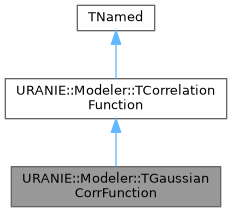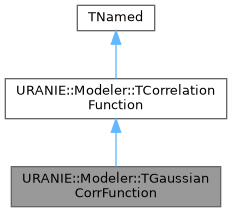Documentation / Manuel développeur
Modules disponibles
Calibration, DataServer, Launcher, MetaModelOptim, Modeler, Optimizer, ReLauncher, Reliability, ReOptimizer, Sampler, Sensitivity, UncertModeler, XmlProblem, |
Uranie / Modeler
v4.10.0
|
Description of the class TGaussianCorrFunction. More...
#include <TGaussianCorrFunction.h>


Public Member Functions | |
Constructor and Destructor | |
| TGaussianCorrFunction (Int_t nbDim, Double_t *corrLength=NULL) | |
| Default constructor. More... | |
| virtual | ~TGaussianCorrFunction () |
| Default destructor. More... | |
Get and Set methods | |
| virtual void | setParameters (Double_t *newParams) |
| Sets the parameters of the gaussian correlation function. More... | |
| void | setCorrLengths (Double_t *corrLength) |
| Sets the correlation lengths. More... | |
Tools | |
| virtual TCorrelationFunction * | clone () |
| Return a clone of the correlation function. More... | |
| virtual void | eval (Int_t n1, Double_t *x1, Int_t n2, Double_t *x2, Double_t *C) |
| Compute the correlation between x1 and x2. More... | |
Printing Log | |
| virtual void | printLog (Option_t *option="") |
 Public Member Functions inherited from URANIE::Modeler::TCorrelationFunction Public Member Functions inherited from URANIE::Modeler::TCorrelationFunction | |
| TCorrelationFunction () | |
| Default constructor. More... | |
| virtual | ~TCorrelationFunction () |
| Default destructor. More... | |
| Int_t | getNParameters () |
| Return the number of parameters of the correlation function. More... | |
| Int_t | getNDimensions () |
| Return the number of dimensions of the input space. More... | |
| Int_t | getNCorrLengths () |
| Return the number of correlation lengths. More... | |
| Double_t * | getParameters () |
| Returns an array containing the parameters of the function. More... | |
| Double_t * | getCorrLengths () |
| Returns an array containing only the correlation lengths. More... | |
| void | setLog () |
| void | unsetLog () |
| void | changeLog () |
| Bool_t | getLog () |
Additional Inherited Members | |
 Public Attributes inherited from URANIE::Modeler::TCorrelationFunction Public Attributes inherited from URANIE::Modeler::TCorrelationFunction | |
| Bool_t | _blog |
| Boolean to decide if the log information is shown or not. More... | |
| Double_t * | parameters |
| array containing the values of the function parameters. Correlation lengths are stored last. More... | |
| Double_t * | _lCorrLengths |
| array containing only the correlation lengths. More... | |
| Int_t | nbDimensions |
| number of dimensions of the input space More... | |
| Int_t | nbParameters |
| total number of parameters More... | |
| Int_t | nbCorrLengths |
| number of correlation lengths More... | |
Detailed Description
Description of the class TGaussianCorrFunction.
This class defines the shape of the correlation between two sets of variables as a gaussian:
\[ c(x1,x2) = exp\left(-\frac{||x1-x2||^2}{lc^2}\right) \]
where \(lc\) is the correlation length.
Constructor & Destructor Documentation
◆ TGaussianCorrFunction()
| URANIE::Modeler::TGaussianCorrFunction::TGaussianCorrFunction | ( | Int_t | nbDim, |
| Double_t * | corrLength = NULL |
||
| ) |
Default constructor.
- Parameters
-
nbDim (Int_t): number of dimension of the input variables corrLength (Double_t*): array of the correlation lengths for the function (size: nbDim). If NULL, the correlation lengths are initialised to 0.1. (default = NULL).
Referenced by ClassImp().
◆ ~TGaussianCorrFunction()
|
virtual |
Default destructor.
Referenced by ClassImp().
Member Function Documentation
◆ clone()
|
virtual |
Return a clone of the correlation function.
The clone must be destroyed by the object (or user) calling the function.
Implements URANIE::Modeler::TCorrelationFunction.
Referenced by ClassImp().
◆ eval()
|
virtual |
Compute the correlation between x1 and x2.
The order of the indices in the flat arrays are the following: x[i+j*d] = X[i,j] where X is a matrix of size (d x n), i is the line index, and j the column index. The results are stored in the flat array C.
- Warning
- Be aware that the matrix corresponding to flat arrays x1 and x2 have input dimensions as LINE, not columns. This means that for a set of point {(a1,b1),(a2,b2),(a3,b3)}, the corresponding matrix X will be: \( \left( \begin{array}{ccc} a1 & a2 & a3 \\ b1 & b2 & b3 \end{array} \right) \)
and the corresponding flat array x = {a1,b1,a2,b2,a3,b3}.
- Parameters
-
n1 (Int_t): number of elements of x1 x1 (Double_t*): data set x1 represented as a flat array (size: d * n1) n2 (Int_t): number of elements of x2 x2 (Double_t*): data set x2 represented as a flat array (size: d * n2) C (Double_t*): correlation matrix represented as a flat array (size: n1 * n2)
- Exceptions
-
UErrorExceptions if the gpLib function returns 1 (evaluation failed)
Implements URANIE::Modeler::TCorrelationFunction.
Referenced by ClassImp().
◆ printLog()
|
virtual |
Reimplemented from URANIE::Modeler::TCorrelationFunction.
Referenced by ClassImp().
◆ setCorrLengths()
|
inlinevirtual |
Sets the correlation lengths.
- Parameters
-
corrLength (Double_t*): array containing the correlation length parameter. If the number of dimension of the inputs is \(nbDim\), the array's size is \(nbDim\).
Implements URANIE::Modeler::TCorrelationFunction.
References setParameters().
◆ setParameters()
|
virtual |
Sets the parameters of the gaussian correlation function.
- Parameters
-
newParams (Double_t*): array containing the parameters of the correlation function. If the number of dimension of the inputs is \(nbDim\), the array's size is \(nbDim\). It is supposed to be of the form: \[ newParams[nbDim] = {lc[0],..., lc[nbDim-1]} \]
where \(lc\) is the correlation length parameter (array of size \(nbDim\)).
Implements URANIE::Modeler::TCorrelationFunction.
Referenced by ClassImp(), and setCorrLengths().


